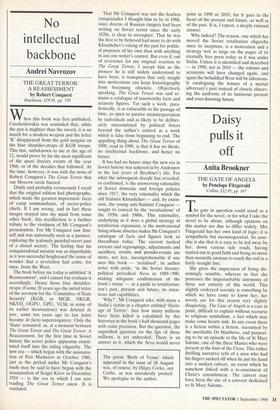Daisy pulls it off
Anita Brookner
THE GATE OF ANGELS by Penelope Fitzgerald Collins, £12.95, pp. 167 The gate in question could stand as a symbol for the novel, or for what I take the novel to be about, although opinions on this matter are due to differ widely. Mrs Fitzgerald has her own kind of logic; it is sympathetic but inconsequential. So anar- chic is she that it is easy to be led away by her, down various side roads, having started out in good faith and being no more than normally anxious to reach the end in a fairly straight line.
She gives the impression of being dis- armingly sensible, whereas in fact she possesses the imperturbable autonomy of those not entirely of this world. This slightly cockeyed serenity is something by which we have come to know her; her novels are for this reason very slightly disquieting. The Gate of Angels is a case in point, difficult to explain without recourse to religious symbolism, a fact which may make some hearts sink. In any event there is a fiction within a fiction, recounted by the unreliable Dr Matthews, and purport- ing to be an episode in the life of St Mary Salome, one of the three Maries who were present at the foot of the Cross. This rather thrilling narrative tells of a man who had his fingers sucked off when he put his hand into a sunken culvert, an event which he somehow linked with a re-enactment of Christ's entombment. The culvert may have been the site of a convent dedicated to St Mary Salome. This admittedly successful detour in a novel which by no means divulges its secrets at first reading compounds a sym- bolism which is both insistent and elusive.
The gate of the title, the gate with which we started, is the back door, as it were, of St Angelicus' College in Cambridge; it has only been opened twice in the 500 years of the college's foundation, and it must never be entered by a woman. It is entered quite matter of factly in the last chapter by Daisy Saunders, a sometime nurse at Blackfriars Hospital in London. She it is who breaks the spell of celibacy, which has had per- ceptible effects on the personalities of its various Fellows, of whom Fred Fairly is the most junior. Fred falls in love with Daisy after waking up in bed with her; they have been involved, variously, in a cycling acci- dent, and their rescuers have simply put them together in the spare room.
Fred is unworldly. He is bothered by the Mind-Body problem (the year is 1912), although his theories are weighted in favour of mind rather than of body. Daisy, on the other hand, knows all about the body. A working-class probationer, she is fully conversant with physical disorder. Describing the contents of an average hospital dispensary in 1912 Mrs Fitzgerald is at her best, just as she is marvellous at detailing the number of dishes, toast-racks, eggcups, knife-rests, tea-strainers, milk jugs, gravy-boats, fish forks, blancmange dishes, compotiers, ramekins, etc, neces- sarily in the possession of a woman whose husband expects to eat three meals a day at home. She is an excellent historian, quietly placing items of information which might have come from old London records, or, alternatively, off the back of a magazine such as the Blackfriars, Vauxhall and Temple Gazette, which she unobtrusively introduces into her overloaded but seam- less plot.
If Fred is unworldly Daisy is comprom- ised, by the editor of the above mentioned Gazette. This man, Kelly, proposes a cou- ple of nights at Pett's Hotel in Cambridge, where Fred, in another part of the town, is worrying about the Mind-Body problem. Fred and Daisy, having met in bed, meet again in the magistrate's court, to which the owner of the cart which knocked them off their bicycles has been summoned. They meet, finally, in the dark of the Cambridge night, after Daisy has entered the closed gate and ministered to the blind Master, who has had some kind of seizure. Is she St Mary Salome? One of the saint's iconographic emblems is a cruet, and Daisy was given a cruet when she left the hospital. This reference goes in pell mell with the rest.
Daisy has broken the spell, and the book is about spells, or perhaps beliefs. It is noticeable that the London chapters are far more brisk and rational than the Cam- bridge ones, which bristle with undigested characters. This author is exceptional when her feet are firmly planted on identifiable soil. She can describe anything; that is her forte. Previous novels have shown her wilfully denying her readers a logical con- clusion, or indeed any conclusion at all. Here she has made an important conces- sion to form and tied up all her loose ends. The result is formidable, but also some- what exclusive, arcane coincidence being part of the deal. But no writer is more engaging than Penelope Fitzgerald. The reader who begs for simple explanations is merely waved on with a smile.



















































 Previous page
Previous page